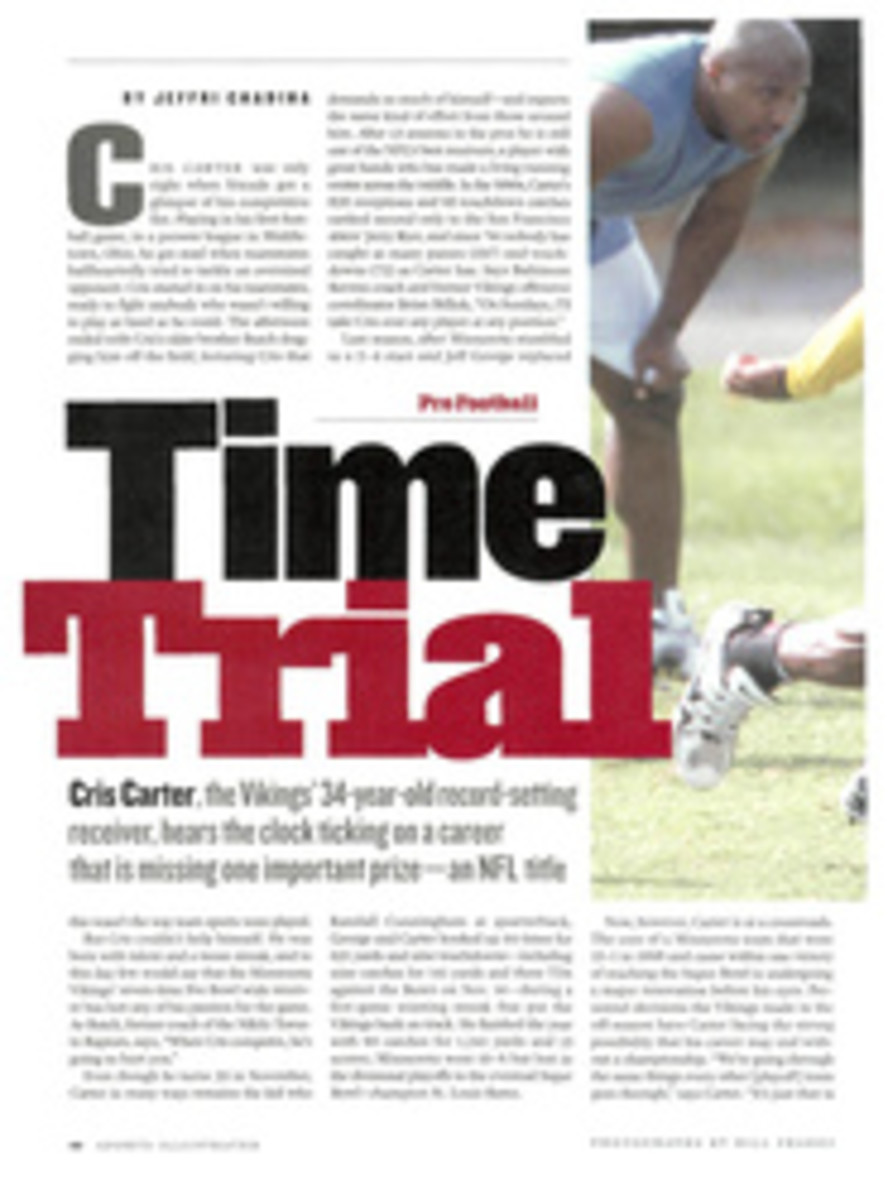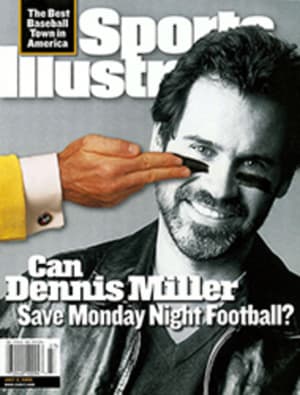
Notebook
Tiger's Edge
Second to One?
Three weeks ago almost everyone agreed that Tiger Woods was
great for golf. The quality of play on Tour would improve, the
argument went, as the other pros tried to keep up with him.
After Woods won the U.S. Open by 15 strokes, though, the same
people wondered if he had raised the bar too high. Isn't it
human nature, they asked, to settle for second when it becomes
clear that one player is superior?
Several experts in human behavior say the short answer is no:
Giving up is not basic human nature. "Social animals, of which
man is one, react to group leaders," says Douglas Candland,
professor of animal behavior at Bucknell. "Horses always run
faster next to one another than by themselves. Animals are
driven by the survival instinct to reproduce a stronger
generation. The same instinct exists in man and is manifested in
sport.
"According to science, an exceptional performance like Tiger's
stimulates better performances. Not from everyone, but generally
the top level rises to meet the standard. Athletes innately
understand this progression of standards. I remember when Babe
Ruth was dying, in 1948, he was asked if he thought anyone would
break his records. He answered, 'Of course. That's what they're
there for.' And his records have been broken."
Sports psychologists say that while nonathletes learn to live
with defeat, pro athletes are much more competitive. "People
talk about rich Tour pros becoming complacent," says Richard
Coop, a sports psychologist, "but I see less complacency since
Tiger arrived, and after what he did at the Open, [we'll see]
even less. Guys are going to reload. You'll see more personal
trainers, more nutritionists, more Lasik surgery, more intense
practice."
That doesn't mean closing the gap on Woods, who leads the World
Ranking by an unprecedented 15 points, will happen overnight.
Sports psychologist Jim Loehr says that in the short term, Woods
has a tremendous advantage. "Just by being himself, Tiger takes
other golfers out of their games," he says. "They see how
comfortable Tiger is at this higher level, and they press and
play worse, not better."
But Loehr agrees with Candland and Coop that for the long term,
Woods is every golfer's best tool for improvement. "Golfers now
know they can go deeper," says Loehr. "Tiger has proved that
beyond doubt golfers benefit from being well-trained. So much of
sports is built on belief systems, and Tiger has changed what
golfers believe is possible."
Tiger-Proofing St. Andrews
Old Course Adds Yards, Bunkers
Every British Open played at the home of golf is special, and
one of the charms of St. Andrews is that the Old Course has
undergone so few changes over the decades. But because players
are hitting the ball so much farther than in the past, the Royal
and Ancient Golf Club has made some significant alterations.
The Old Course has grown by about 200 yards since 1995, when it
last hosted the Open, and now plays at 7,115 yards. The most
substantial changes came on a pair of back-nine par-4s, the 15th
and 16th. Both have been lengthened by about 40 yards--to 456
and 424 yards, respectively--by moving the tees back, and as a
consequence their fairway bunkers, which most Tour players had
been able to fly with their drives, are once more in the landing
area.
Only a few players can carry them now. You know who one of them
is. Most pros feel trying to Tiger-proof any course, much less
the Old Course, is a mistake. "[Woods] won't have to think about
those bunkers," says Nick Price. "He'll fly them while the rest
of us have to manipulate the ball around them."
The R&A has not said whether it intends to narrow the fairways
any more than in '95, when a victorious John Daly blasted his
driver with impunity. If it leaves them as they are, and
conditions are calm, Woods could drive at least four of the Old
Course's 14 par-4s: the 352-yard 9th, the 379-yard 10th, the
314-yard 12th and the 357-yard 18th.
COLOR PHOTO: ELISE AMENDOLA/AP Role model Woods's nonpareil inner drive is his (and his Tour peers') best tool for improvement.
COLOR PHOTO: ROBERT BECK
COLOR PHOTO ILLUSTRATION
COLOR PHOTO: JIM MIDGETT
COLOR PHOTO: BOLIVAR ROSERO
COLOR PHOTO: BRIAN SPURLOCK
Trust Me
If the Europeans want a real home field advantage in the 2001
Ryder Cup, they could dump the Belfry, an American-style course,
and move to a seaside links that would be similar to Pebble
Beach. The leader board from the U.S. Open, the major in which
the Euros usually struggle, said it all. Two Englishmen, an
Irishman and a Spaniard were in the top seven.
Threesomes
What do these players have in common?
--Olin Browne
--Stewart Cink
--Brent Geiberger
In consecutive years, each got his first Tour win at the Greater
Hartford Open: Cink in 1997, Browne in '98 and Geiberger in '99.
Feedback
Should disciplinary action be taken against John Daly for
withdrawing from the U.S. Open without cause?
Yes 48%
No 52%
--Based on 4,386 responses to our informal survey
Next question: The way Tiger Woods's hairline is receding, is
the Michael Jordan solution in his future? Here's what Woods
would look like if he shaved his head. Should he or shouldn't
he? Vote at golfplus.cnnsi.com.
Numbers
Gender equity? Not in golf, where women remain second-class
citizens. Here's how much the two biggest winners on the three
U.S. tours have earned this year.
Starts Wins Money
Tiger Woods 11 5 $4,949,731
Hal Sutton 16 2 $2,478,710
Larry Nelson 17 2 $1,213,280
Bruce Fleisher 16 3 $1,180,474
Karrie Webb 11 4 $953,463
A. Sorenstam 12 3 $700,635
Faces
Chip Carter, Dallas
Carter, 33, an insurance agent, shot a three-under 210 for
victory in the Texas Golf Association Amateur Championship at
Lakewood Country Club in Dallas. Carter finished a shot ahead of
John Gough of Heath. In April, Carter and David Pettle of Dallas
teamed to win the prestigious Azalea Invitational in Tyler, Texas.
Meaghan Francella, Port Chester, N.Y.
Meaghan, 18, was victorious at the AJGA Izzo Junior, shooting an
eight-over 224 to beat Christy Larimore of Severna Park, Md., by
five strokes. The two-time defending New York State Girls'
Junior champ, Meaghan grabbed the 1999 Metropolitan and
Westchester girls' titles. She plans to attend the University
of Memphis on a golf scholarship.
Pete Wojtowicz, Greenwood, Ind.
Wojtowicz, 40, the owner of three McDonald's restaurants, became
the first amateur to win the 20-year-old Indianapolis Open. He
shot a six-under 134 at Highland Golf and Country Club and
finished two strokes ahead of Kyle Marsh, the assistant pro at
Highland. Wojtowicz also prevailed at the Bonita Bay
Invitational in Naples, Fla., in 1999 and '00.
Submit Faces candidates to golfplus.cnnsi.com/faces.

